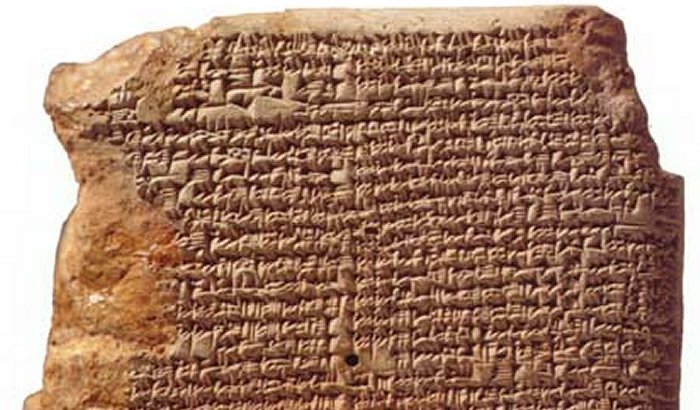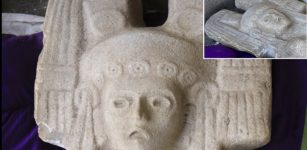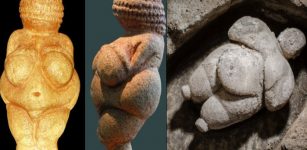MUL.APIN Tablets: Babylonian Knowledge Of Astronomy And Astrology Recorded In Cuneiform Writing
A. Sutherland - AncientPages.com - Systematic observations of the sky were carried out by Babylonians living in southern Mesopotamia in the middle of the third millennium BC.
 MUL.APIN, a Babylonian compendium that deals with many diverse aspects of Babylonian astronomy and astrology. source
MUL.APIN, a Babylonian compendium that deals with many diverse aspects of Babylonian astronomy and astrology. source
The result of these observations defined the concept of the ecliptic and its division into twelve parts, along which they placed twelve signs of the Zodiac. The MUL.APIN cuneiform tablets - the essential source of Babylonian astronomy - represent a set of ancient astronomical records that are believed to be forerunners of the present-day zodiac.
At the time of their introduction, they coincided with constellations with the same names. The tablets were created in Babylon around 687 BC and contained approximately 200 astronomical observations, including measurements related to several constellations.
Long-Lasting Debate On MUL.APIN Cuneiform Tablets
However, many archaeologists believe they are only transcriptions of much earlier records of astronomical observations made by Assyrian astronomers, who observed their sky about 2,300 BC.
The date of the origin of these observations has been disputed for a longer time.
The earliest copies were recovered from the royal library of the Assyrian King Assurbanipal (667-629 BC) in Nineveh and also from Assur.
Now, the majority of scholars believe that the MULAPIN text was originally compiled around 1000 BC, while the latest copies date back to around 300 BC.
The text on the tablets corresponds to the first constellation of the year, MULAPIN "The Plough," which is identified with the double star in the constellation of Andromeda, about 350 light-years from the Earth, known as Triangulum plus Gamma Andromedae. Today we can quickly locate these bright stars in the sky because they form the Big Dipper.
Further, the text lists the names of 66 stars and constellations and further gives a number of indications, such as rising, setting, and culmination dates, that help to map out the basic structure of the Babylonian star map.
When Bradley Schaefer, an astrophysicist at Louisiana State University in Baton Rouge, studied the MUL.APIN tablets, he calculated that the observations date back to 1,370 BC, give or take a century. The observations include the day each year that certain constellations first appeared in the dawn sky and were recorded in the region of Assur.
However, these dates change over the millennia because of a tiny wobble in the Earth's axis.
Small Tablets Of Great Importance
The text covers two MUL.APIN tablets, and possibly a third additional one, which still remains unrecovered.
The first tablet (8.4 centimeters high incised with miniature cuneiform) is the most important resource for any potential reconstruction of the Babylonian star map as its various sections locate the constellations in relation to each other and to the calendar.
All the major stars and constellations are listed and organized into three broad divisions according to celestial latitude assigning each star to three paths:
The first is the northern path of Enlil, containing 33 stars or constellations; the second is the equatorial path of Anu, containing 23 stars or constellations.
The third one is the southern path of Ea ("Whose House Is Water"), widely known as Enki, the Sumerian god of water, knowledge, mischief, crafts, creation, and one of the Anunnaki. The path of Enki contains 15 stars or constellations.
The heliacal rising dates of 34 stars and constellations are given according to the 360-day 'ideal' calendar year.
In the MUL.APIN tablets, an 'ideal' year composed of 12 'ideal' months, each of which was composed of an 'ideal' 30 days, even though the Babylonians used a lunisolar calendar, indicating both the Moon phase and the time of the solar year.
The second MUL.APIN tablet deals with the Babylonian methods and procedures to regulate the calendar and predict the movements of the sun, moon, and planets.
It is believed that there was also the third tablet (yet undiscovered=), and this one most probably explained celestial (astrological) omens.
Written by - A. Sutherland - AncientPages.com Senior Staff Writer
Copyright © AncientPages.com All rights reserved. This material may not be published, broadcast, rewritten or redistributed in whole or part without the express written permission of AncientPages.com
Expand for referencesReferences:
Hunger H. The Babylonian Astronomical Compendium MUL.APIN
Pannekoek A. A History of Astronomy
Rochberg F. Before Nature: Cuneiform Knowledge and the History of Science
More From Ancient Pages
-
 Visit The Palace Where Alexander The Great Was Born In Pella
Archaeology | Oct 21, 2020
Visit The Palace Where Alexander The Great Was Born In Pella
Archaeology | Oct 21, 2020 -
 Scribes: One Of The Noblest And Highly Recommended Professions In Ancient Egypt
Featured Stories | May 10, 2023
Scribes: One Of The Noblest And Highly Recommended Professions In Ancient Egypt
Featured Stories | May 10, 2023 -
 Enigmatic Nok Culture: A Sub-Saharan Archaeological Puzzle
Civilizations | Mar 7, 2020
Enigmatic Nok Culture: A Sub-Saharan Archaeological Puzzle
Civilizations | Mar 7, 2020 -
 Anglo-Saxon Warlord’s Grave: Archaeologists And Metal-Detectorists Work Together
Archaeology | Oct 7, 2020
Anglo-Saxon Warlord’s Grave: Archaeologists And Metal-Detectorists Work Together
Archaeology | Oct 7, 2020 -
 Buccaneers And Privateers Were Pirates – But What’s The Difference Between Them?
Ancient History Facts | Nov 5, 2016
Buccaneers And Privateers Were Pirates – But What’s The Difference Between Them?
Ancient History Facts | Nov 5, 2016 -
 Mansehra Rock Edicts – Last Words Of Emperor Ashoka
Featured Stories | May 27, 2019
Mansehra Rock Edicts – Last Words Of Emperor Ashoka
Featured Stories | May 27, 2019 -
 Never-Before-Seen Ancient Frescoes Discovered Inside The Dormition Cathedral
Archaeology | Feb 28, 2020
Never-Before-Seen Ancient Frescoes Discovered Inside The Dormition Cathedral
Archaeology | Feb 28, 2020 -
 Archaic Hominins Began Sea-Crossings The Aegean Sea 450,000 Years Ago
Archaeology | Dec 22, 2022
Archaic Hominins Began Sea-Crossings The Aegean Sea 450,000 Years Ago
Archaeology | Dec 22, 2022 -
 15 Precious Ancient Objects Returned To Greece From Switzerland – Antique Dealer Charged With Trafficking
Artifacts | Feb 3, 2023
15 Precious Ancient Objects Returned To Greece From Switzerland – Antique Dealer Charged With Trafficking
Artifacts | Feb 3, 2023 -
 Ancient Roman Joke Inscribed On A 2,000-Year-Old Pen – Discovered
Archaeology | Jul 29, 2019
Ancient Roman Joke Inscribed On A 2,000-Year-Old Pen – Discovered
Archaeology | Jul 29, 2019 -
 God Odin Was Exiled From Asgard – The Kingdom Of The Gods – But He Had No Regrets For Breaking Norse Society’s Norms
Featured Stories | Feb 10, 2018
God Odin Was Exiled From Asgard – The Kingdom Of The Gods – But He Had No Regrets For Breaking Norse Society’s Norms
Featured Stories | Feb 10, 2018 -
 Alexander Nevsky: Grand Prince Of Novgorod, Skilled Fighter, Quick–Thinking Strategist Who Defeated Swedish And German Invaders
Featured Stories | Feb 22, 2019
Alexander Nevsky: Grand Prince Of Novgorod, Skilled Fighter, Quick–Thinking Strategist Who Defeated Swedish And German Invaders
Featured Stories | Feb 22, 2019 -
 Rare Six-Foot-Tall Female Statue Accidentally Unearthed By Mexican Farmers
Artifacts | Jan 10, 2021
Rare Six-Foot-Tall Female Statue Accidentally Unearthed By Mexican Farmers
Artifacts | Jan 10, 2021 -
 Viking Ivar The Boneless Could Be Buried In Repton – Remarkable Viking Burial Holds Clues To Where Ragnar Lodbrok’s Son Died
Featured Stories | Jun 17, 2022
Viking Ivar The Boneless Could Be Buried In Repton – Remarkable Viking Burial Holds Clues To Where Ragnar Lodbrok’s Son Died
Featured Stories | Jun 17, 2022 -
 Basajaun: Giant Blacksmith, ‘Lord Of The Woods’ And How People Learned Secrets Of Agriculture
Featured Stories | Aug 27, 2020
Basajaun: Giant Blacksmith, ‘Lord Of The Woods’ And How People Learned Secrets Of Agriculture
Featured Stories | Aug 27, 2020 -
 Danger Lurking In The Woods – Mysterious Vanishings, Deaths And Unusual Behavior – Part 3
Featured Stories | Jul 9, 2018
Danger Lurking In The Woods – Mysterious Vanishings, Deaths And Unusual Behavior – Part 3
Featured Stories | Jul 9, 2018 -
 Durendal – Magical Sword Of Knight Roland That Cut Stone Boulders With A Single Strike
Featured Stories | Jan 19, 2022
Durendal – Magical Sword Of Knight Roland That Cut Stone Boulders With A Single Strike
Featured Stories | Jan 19, 2022 -
 ‘Venus of Willendorf’: New Theory On ‘Venus’ Figurines – Proposed
Artifacts | Dec 1, 2020
‘Venus of Willendorf’: New Theory On ‘Venus’ Figurines – Proposed
Artifacts | Dec 1, 2020 -
 Mysterious Bones May Re-Write History Of North America – Humans Were Present On The Continent 10 Times Earlier
Archaeology | May 8, 2017
Mysterious Bones May Re-Write History Of North America – Humans Were Present On The Continent 10 Times Earlier
Archaeology | May 8, 2017 -
 Evidence Of Carthaginian Presence In Northern Europe?
Featured Stories | Jun 18, 2022
Evidence Of Carthaginian Presence In Northern Europe?
Featured Stories | Jun 18, 2022

